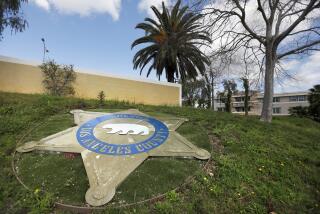County Unit Makes Life Tougher for Gangs
- Share via
The heat started coming down on the street last June.
It began after the death of 82-year-old Cornelia Mitchell of Buena Park. She was sitting in her living room when bullets from a gang member’s gun sprayed her neighbor’s house. One of them pierced Mitchell’s front door and struck her in the chest.
Almost immediately, local gang members became tight lipped, while rival gang bangers in Anaheim went underground.
What gang bangers didn’t know was that a few months earlier a new county anti-gang unit had been activated. The heat was turned up, and within a week Buena Park police and investigators from the new unit arrested several suspects, including Ignacio Vargas of Anaheim, then 17 and suspected of being the shooter.
A year has passed since Dist. Atty. Cecil Hicks and Orange County Supervisor Roger R. Stanton first proposed the anti-gang unit. With subsequent funding of $450,000, the new program aimed at the county’s growing gang problem.
“It’s too soon to call it totally successful,” said John D. Conley, the deputy district attorney in charge of the unit. But the program already has won praise from the county grand jury and from several Orange County police departments.
Since its inception, the unit also has:
- Established a central file of more than 7,000 names of gang members and their associates.
- Prosecuted 50 juvenile trials and lost three, for a conviction rate of 94%.
- Sent 17 people to state prison, 21 to the California Youth Authority, 27 to jail and 307 to Juvenile Hall.
- Filed six cases of homicide, nine of attempted murder, 54 of assault with a deadly weapon, eight of shooting into houses and 36 of robbery.
The program uses an approached called “vertical prosecution.” That means that once a gang member is arrested, a unit prosecutor and an investigator are assigned to the case permanently. In the past, Conley said, the case might have bounced to different prosecutors for various court appearances. “Continuity would be lost,” he said.
Lt. David Salazar of the Santa Ana police praised the idea and the increased cooperation between his department and the anti-gang unit, which, he said, has “resulted in sentencing some gang members to 20 years, even 30 years, and that’s got to be a deterrent. Working together, we’ve also been able to target the ringleaders,” Salazar said.
In the Buena Park shooting, the Vargas case was turned over to Deputy Dist. Atty. Thomas Avdeef, one of six prosecutors in the unit. (The unit also includes five investigators and a clerical staff of three.) Vargas was prosecuted as an adult and convicted of first-degree murder on March 2, Avdeef said. His sentencing is scheduled for April 28.
Other successful cases by the special anti-gang unit include a conviction of a Diamond Street gang member from Los Angeles for the murders of two young men in a gun battle in the streets of Santa Ana in 1984. The killer was sentenced to 42 years to life in prison.
The unit also won felony assault convictions against three alleged neo-Nazi skinheads from Huntington Beach who beat a Laguna Beach man in a gay-bashing incident. Avdeef, who prosecuted the case, said it was the first conviction in the state under a 1987 civil-rights statute that outlaws crimes of hatred against a specific group, such as homosexuals.
Conley’s unit has determined that there are 98 gangs in Orange County. Seventy-nine percent are Latino and 19% are black. Others are Asians, skinheads and those who migrate from outside the county.
Some of the newer groups are “mutant” gangs, Conley said.
“These are youths who live in certain gang areas who come up with their own gang. Usually it starts as a pretend gang then becomes an actual gang,” he said.
The anti-gang prosecutors also have quietly changed some rules in the courtroom. For instance, the unit won a court order allowing police and school officials to openly discuss activities of gang members without violating school confidentiality laws protecting students, Conley said.
“The schools were leery of talking to police about gang kids because of the confidentiality law, and the police were worried about leaking sensitive juvenile criminal information to school officials,” Conley said. “The order doesn’t force anyone to talk to each other but allows them to talk about gang members without fear of being sued.”
More to Read
Sign up for Essential California
The most important California stories and recommendations in your inbox every morning.
You may occasionally receive promotional content from the Los Angeles Times.













